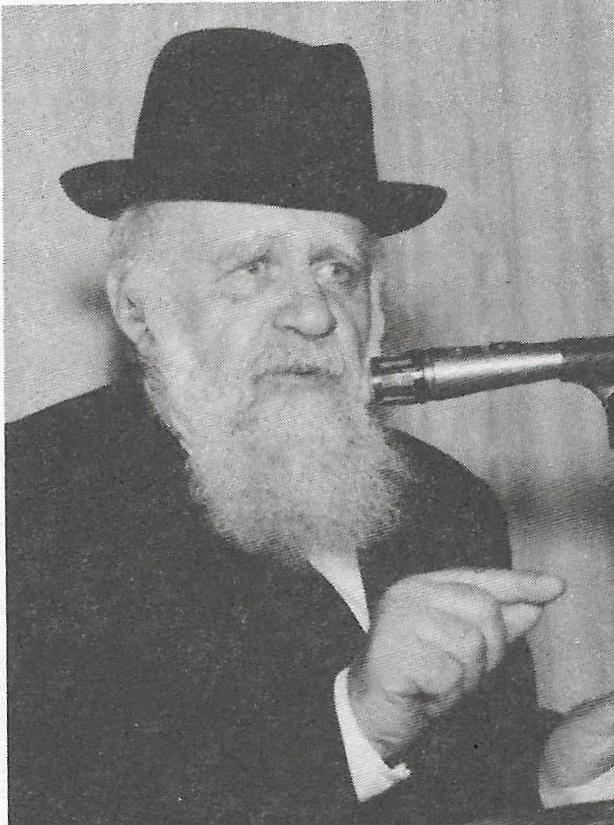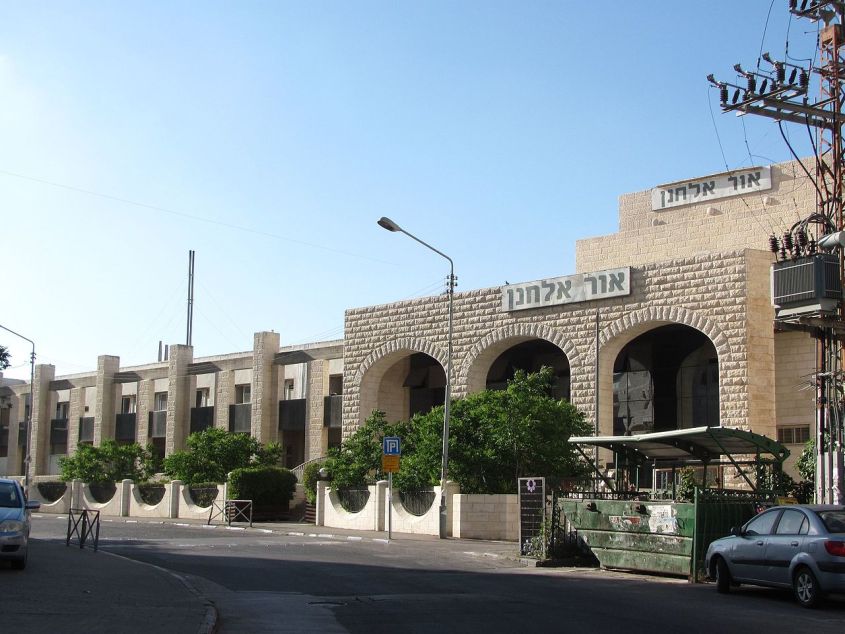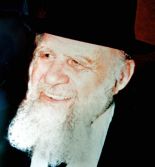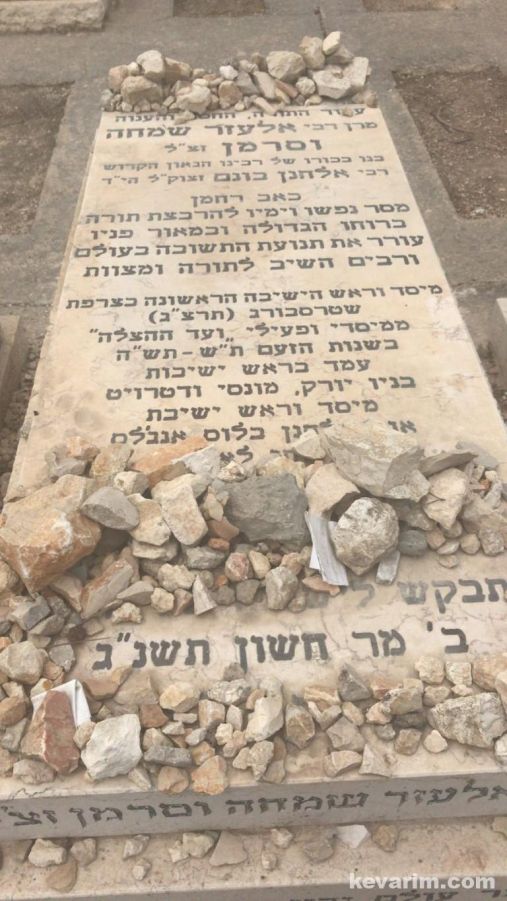| | NEWS
The Unassuming Greatness of Reb Simcha Wasserman
by Yakov Branfman

This article appeared in print in 1992, that is, 31 years ago. HaRav Wasserman was niftar on 2 Cheshvan, 5753 (October 29, 1992). He was about 93 years old.
For Part I of this article click here.
*
Part 2
Rav Nachman Bulman, who knew HaRav Simcha Wasserman for almost fifty years, formulated what may be the central question:
"He wasn't a person who was looking for "madregas," but he had them. That's what a Yid is supposed to be. If you were to ask anybody who got to know Reb Simcha, `What was he?' the answer was not obvious. Certainly everybody knows that he was a talmid chochom, and an ehrlicher Yid, and a yirei shomayim, a baal midos tovos, a baal chesed godol and a true educator. And he was never inconsistent with his emes. But, with all this, it could still be asked, `What was he?'"
In his discussions on the difference between mechusa and nistar, Reb Simcha would sometimes pick up item on the table, put it under his coat, with the bulge visible, and say, "That's called mechusa. You do not see what I carry, but you see that I carry something. That's not nistar. Much of novi is mechusa. In Chumash, the stories seem so simple and the art is so great, that you don't even necessarily notice that there is something under the surface. That's nistar."
It could be said about Reb Simcha also, that his art was very great. He seemed so simple and so accessible. Yet there was nonetheless something hidden that made one ask, "What was he?"
The Years In Eretz Yisroel
The enormous dedication and self-sacrifice that all this required did not stop even in old age. In 1979, he and his rebbetzin were finally able to fulfill their life's dream of living in Eretz Yisroel. They moved into the neighborhood of Mattersdorf, which is a continuation of the Torah neighborhoods of Ezras Torah, Unsdorf, and Itri. It is a neighborhood full of children.
He talked about the little park that sits at the entrance to Ezras Torah. "You can go there sometimes, and it looks like it's full of flowers. It's all children! They're filling the entire park like flowers."
The yeshiva in Jerusalem

Once in Eretz Yisroel, he immediately set to work on the project that would occupy the great majority of his time and energy for the rest of his life: The establishment of a Torah center and a major institution of learning at the highest levels. He and HaRav Moshe Chodosh established Yeshivas Ohr Elchonon in Jerusalem.
Reb Simcha considered the yeshiva to be most closely following in the ways of his father, Reb Elchonon, zt'l. He expressed and demonstrated until the very end of his life that he considered the yeshiva to be the crown jewel in his long career; the culmination and fulfillment of all his years of working for Torah. He poured into it the wisdom and experience gained during the more than sixty years he spent raising talmidim and building institutions of learning, prior to his arrival in Eretz Yisroel.
He came to it in his old age but worked on it like a young man. Endless discussions. Endless meetings. Intimate and detailed involvement in every area of its establishment. And the travels...
Even at his advanced age, he never hesitated to pack up his suitcases and take off once again on behalf of the yeshiva. Europe, South Africa, America.
The demand for admission into the yeshiva increased to the point that the yeshiva outgrew its facilities. Even though he was close to the age of 90, he took it upon himself to provide the major means for a new building in Romema. More plane flights, more taxi rides, more discussions with friends, and, due to his concern for the well-being of everyone and his unique ability to become friends with everyone, the people he talked to were truly his friends.
When the first phase of the building program was completed, the yeshiva was finally able to move into the new building in early 1992, and Reb Simcha's happiness was boundless. He also actively participated in the foundation of the branch of the yeshiva in Tiveria.
He gave shiurim in mussar, halacha, and gemara to the students in both branches. Each one felt his warmth and dedication to their well-being. Stories of his effect on individual students are told over and over again in the yeshiva.
Rav Chodosh talks about the times that Rav Simcha spent Shabbos or Yom Tov together with the students in the yeshiva. "The Yomim Tovim were beautiful when he was there! He was there living among us, eating with the bochurim on Shabbos, or Rosh Hashana night. Talking with everyone. Sometimes giving shiurim. How much that added! It was a completely different atmosphere. There was nothing else like it.
"Although he gave us the most special experience in those times, he was very careful not to benefit in any way from the yeshiva. All his self-sacrifice on behalf of the yeshiva was in order to provide a place for students to learn, and to do this in memory of his father.
"In the beginning, he would attempt to give me a check after Yom Tov for the food he had eaten. I said, `Impossible! How can I take a check from you!? You came for us.'
"Still, he wanted to pay for his food. He didn't want to accept my refusal.
"From then on, after Shabbos or Yom Tov, he would give me a check and write on it that it was for payment for an aliya to the Torah that he had received. Or for money promised during Yizkor. It was a neder. I wasn't able to refuse. And the check that he gave wasn't just for expenses. It was as if he had been at a five star hotel."

Dawn: Reaching The New Generation
The baal teshuva movement had begun to bloom during the time he was living in Los Angeles, and he opened up his yeshiva, his house, and his heart to the new generation. When he moved to Eretz Yisroel, he also continued his special attention to baalei teshuva. For both meals on Shabbos, his table was overflowing with guests sent to him from the Kosel. Friday night was for the young women, and the afternoon meal for the men. Then the next week, the men would come at night and the women in the daytime.
Sometimes the daytime visitors would be surprised to see their host eating extra plates of cholent at the end of the meal. What they didn't realize was that Reb Simcha knew that the Rebbetzin preferred not to have cholent left over. So, when necessary, he himself would finish it off.
Once a week, he gave a question and answer shiur for the very beginners in Yiddishkeit. He called it "Shut-Ohr Somayach."
One of the very last times he was there, he was asked, not untypically, "What's all this talk about gemara!? All the time, gemara, gemara, gemara! What do we need it for?"
He broke into a big smile as he heard the question and the smile spread as he began to answer, "Okay. I see I'm going to have to explain everything to you. Let's go!"
The following thought, which Reb Simcha expressed a number of times, may have been one of the main ideas which motivated him in his drive to reach out to all Jews.
The Torah is a Toras chaim. The Torah has life in it. And the life in Torah is what the Ribono Shel Olam gave us, because it came to us directly from the Ribono Shel Olam to Moshe Rabbenu to Yehoshua and further and further. Rambam lists all forty generations from Moshe Rabbenu to Rav Ashi who finally edited the Talmud Bavli. It's all a long chain from the Ribono Shel Olam.
When we learn Torah we don't learn Torah for ourselves. Each and every Jewish person is a link in the chain of receiving the Torah from Moshe Rabbenu, from the Ribono Shel Olam, and forwarding it to somebody else; to the next generation. That's why the mitzvah of Torah study is not only to study, but to study and to teach it. Because a person who learns Torah is a link in that eternal chain from the Ribono Shel Olam through generations.
There is blood circulation in the body. What would happen if there would be a clot in one place? It can't go further.
It's the same if Torah comes to a person and he stops it there. If he doesn't give it further, it's a clot. It's all one chain. So therefore the entire life of Torah is because it comes directly from the Ribono Shel Olam. Every word that we learn is a dvar Hashem.

How To Educate
He took his theory of educating newcomers from the Rambam. "What we can do in America is just be friendly, be warm. Because they deserve it. The Rambam says not to criticize people who have been raised in a non-Torah environment. They are blameless, because they don't know. This is the way they were raised.
"Therefore, says the Rambam, we have to do something for them. We should attract them with peaceful words until they will return to the strength and the motivation of Torah. Torah is the best salesman for Torah. The Rambam meant to learn Torah.
"But learning Torah without the intention to live up to it is a Torah that is a shell. It has no life to it. So, in the beginning years in California, I learned the story of Avrohom. Parshas Lech Lecha. No obligations and no commitments. Later on, people said to me, `You never told me to observe Shabbos.' I didn't do it. Torah did it."
From a student from Los Angeles: "When I first came to him, he didn't talk to me about tefillin. That was liable to push me away. When he saw that I was ready, he came to me one Erev Yom Kippur with a gift of tefillin."
Reb Simcha lived long enough to fulfill what might have been his own personal prophecy that night, long ago in Telz, when he saw the three different skies at one time. He lived through the sunset, and the nighttime, and his happiness at being an active part of the dawn was apparent to everyone around him.
He looked back on the past, and commented, "Twenty five years ago it was not like this. You cannot compare conditions today with the way they were then. Look magazine came out with an article then on "The Vanishing Jew in America." What happened was that the magazine vanished. There's no more Look magazine.
"But it said something. That in America —in the whole world as it was then — the Jew was vanishing. Now there is a revival, a renaissance, which is miraculous. Wonders which we can't explain! The wonders of our survival."
Bright Sun: Reb Simcha's Ahavas Yisroel
During his first two years in Los Angeles, his rebbetzin stayed behind in Detroit, and continued to send him her salary so that he would be able to live on it. It was very hard for him to be separated from her.
Once he wanted to come back, to give up. She let him know that "if HaKodosh Boruch Hu didn't give us children, it's for the sake of what you are doing. What else will we leave over? So I insist that you have to continue being what you are until you will be able to influence people in the way you want to influence them. Until you will be able to educate them in the way you need to educate them. And that you will remain there until many yaldei Yisroel will be our children."
Eventually, he became a rebbe and a father to many hundreds of families in different cities who became deeply attached to him, who loved him and honored him in a manner that was rarely seen in our generation.
On his last night in Eretz Yisroel, he and his Rebbetzin prepared to leave Jerusalem at 4 a.m. the next morning to travel to America for a family bar mitzvah, a trip that was supposed to last only one week. A number of his students and neighbors showed up at his house, perhaps sensing that this would be their last time with their rebbe.
They came to say good-bye, to ask for brochos, and, as always, to express their love. A newcomer to the scene sat in the corner of the room, speechless at the outpouring of love that was being expressed towards Reb Simcha.
On Reb Simcha's part, he never became friends with anyone through the use of flattery. He simply personified emes, love, and the truth of Torah.
He once told someone, "You can't make someone be your friend, but you can be a friend to someone and hope they'll reciprocate."
In Reb Simcha's case, they reciprocated in a way that is impossible to describe.
His life was a story of kindness, compassion, and understanding. He sacrificed himself at every moment. Another student from Los Angeles said, "He was only there for you."
He was completely dedicated to the well-being of every Jew, and he realized that this could only come about through Torah. He did all this in a quiet, unobtrusive way, in a manner that made each and every person feel that he was sublimely happy to meet him and to get to know him.
It is important to mention that anything that is said about HaRav Wasserman is equally applicable to his Rebbetzin, Fayge Rochel, o"h. They came from the same "training ground." They both grew up amongst gedolei Torah, in the midst of the greatness of the yeshiva world of pre- World War II. They traveled from there together and were not just "at peace" with each other, but shared the same ideals throughout their lives. She sacrificed, on the same level, as much as he did for their ideals and they were truly one soul — not just one body — for over sixty years.
The Rebbetzin lived, after his passing, long enough to sit shiva for him, and then spent one more Shabbos without him. That Shabbos was spent in Yeshivas Ohr Elchonon, where she, characteristically, in the midst of her pain over the loss of her husband, was a giver once again.
A group of Russian students were spending Shabbos in the yeshiva, and because of her ability to speak Russian, they were brought to talk with her. They spoke together for a long time, and clearly the students were all very moved. They had never met anyone like her before. On motzei Shabbos the Rebbetzin fell ill, and the next morning she passed away.
HaRav Bulman talked about what gave Reb Simcha the ability to accomplish so much and to maintain such enormous strength until the very end of his life.
"He was endless in his energies. Until the very last few months, his energy was that of a young man. His firmness in his step, his walking, his coming, his going, his eyes, his face. It wasn't a ninety-year old man. And more important, the smile in the eyes. It's not replaceable. That was the product of a factory whose head was Reb Elchonon, and whose head over the head was the Chofetz Chaim and the Torah community of the great yeshivas of Europe, and his connections with gedolim from every sector.
"There was, about him, a feeling that a person who has that kind of energies until his very old age, had to be a tahor einayim and a tahor lev, and that he was tahor in every way. There was always such a feeling about him. He never saw bad. He saw things that were bad. But people, not. That he didn't see."
Rav Simcha talked about the gemara in Kesuvos (17a) which says that when the chachomim ordained the great Rav Zeira, they sang to him these words: lo kechal, velo serak, velo pirchas — veya'alas chein! meaning, "He does not adorn himself, but in him is all the beauty."
The idea, Reb Simcha said, is not that Rav Zeira had beauty and refinement even though he didn't adorn himself, but rather, because he didn't adorn himself, he had the true original beauty and refinement.
HaRav Chodosh adds, "The gemara is saying that this is how a rav should be. No exaggeration. No self-inflation. Humility. Simplicity. Clearly the gemara is talking about the Rosh Yeshiva, zt'l."
Again, Rav Bulman's question: What was he? Everybody knows he was a talmid chochom. And an ehrlicher Yid. Also a yirei shomayim, a baal midos tovos, a baal chesed godol, a true educator. And he never became inconsistent with his emes. But, after all this, someone might still be moved to ask, "What was he?"
The answer is: He was a Yid. This is a Yid.
|




